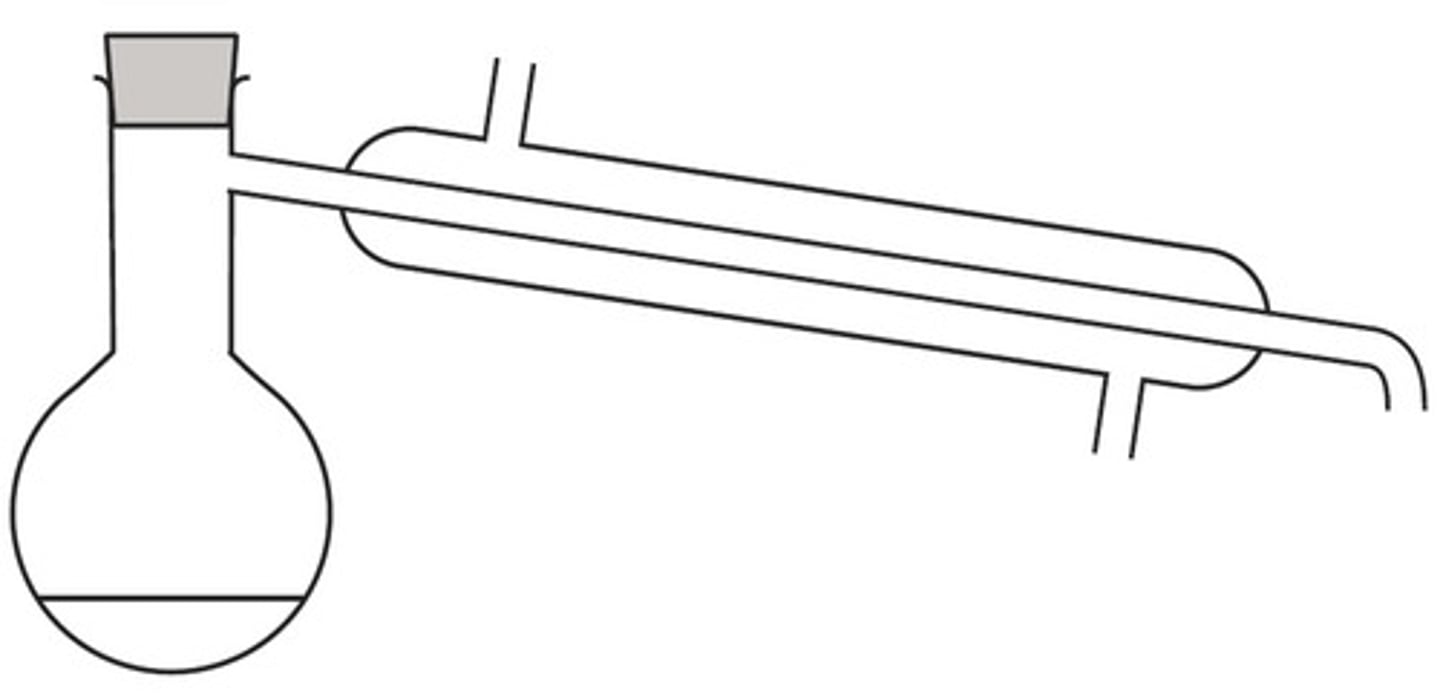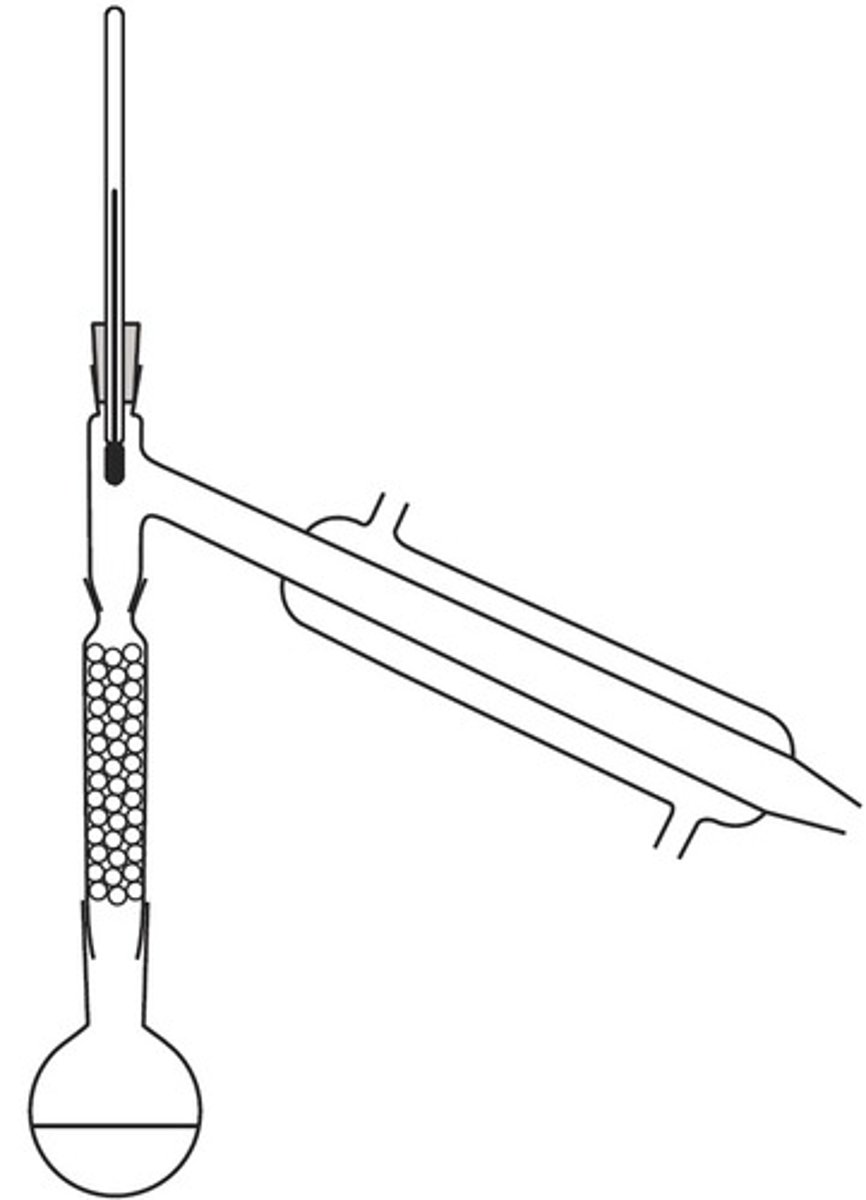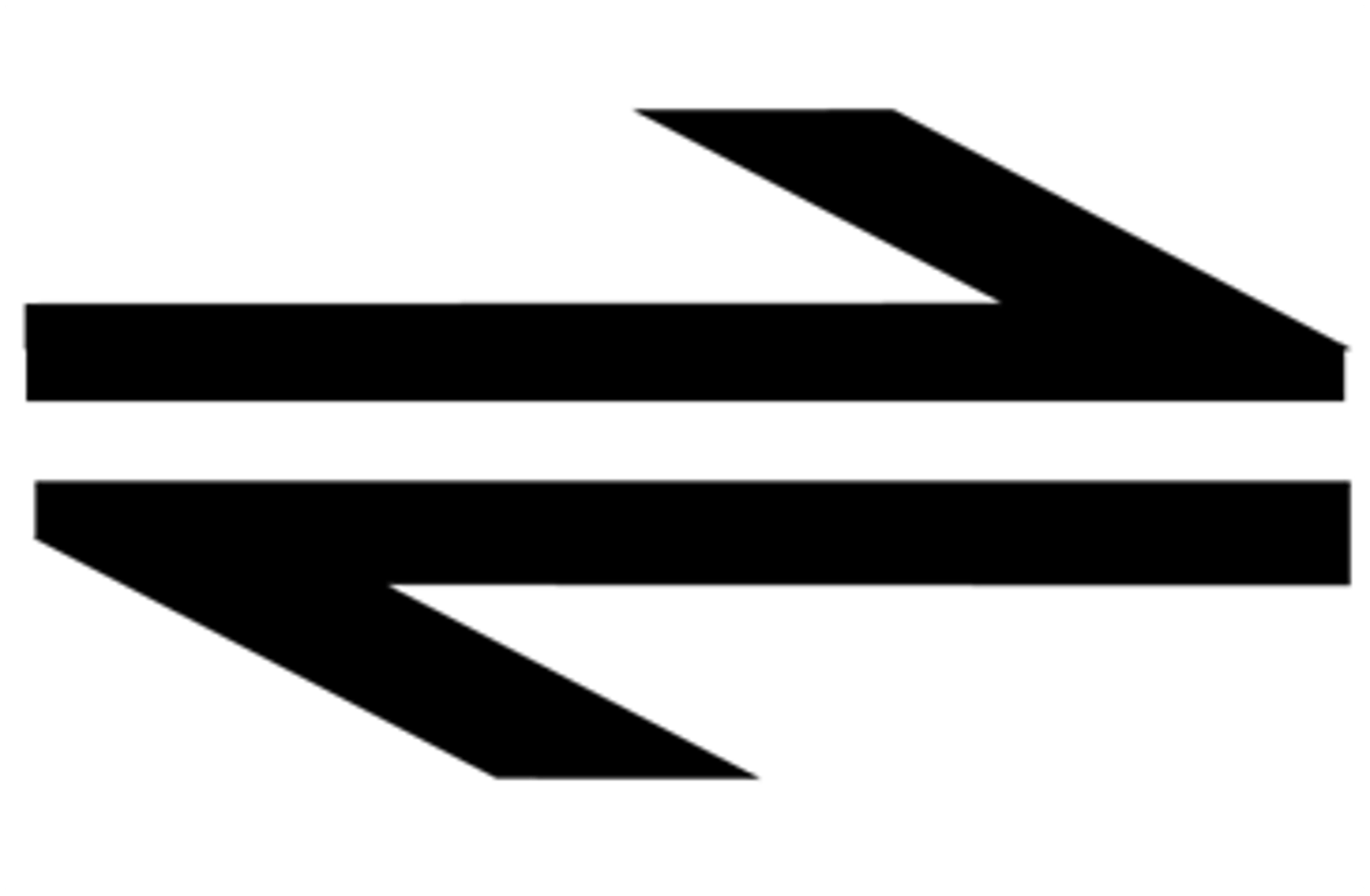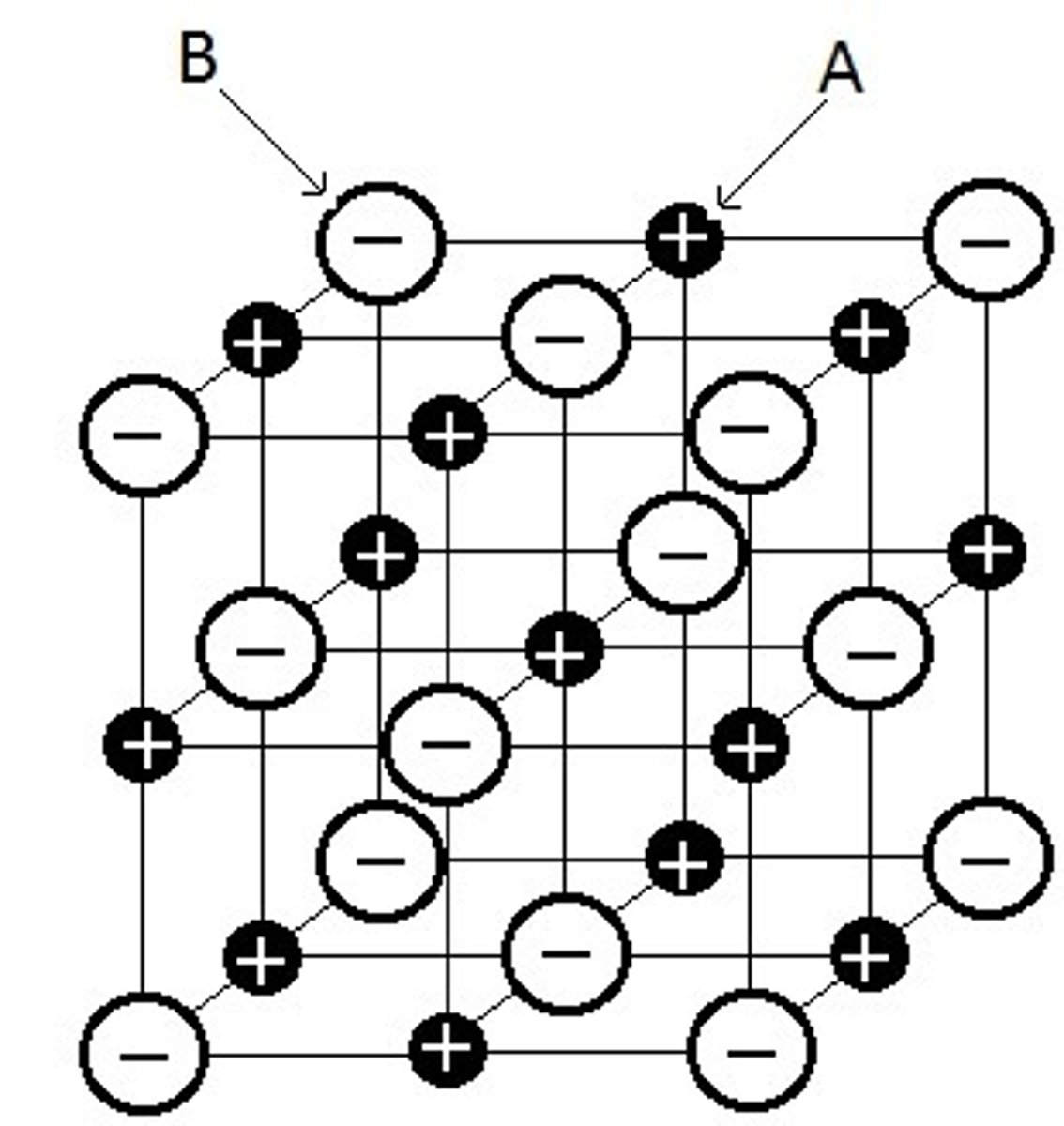IGCSE Chemistry
1/595
There's no tags or description
Looks like no tags are added yet.
Name | Mastery | Learn | Test | Matching | Spaced |
|---|
No study sessions yet.
596 Terms
State the method used to obtain sand from a mixture of sand and water
filtration
State the method used to obtain solid copper sulfate from aqueous copper sulfate
crystallisation
State the method used to obtain red food dye from a mixture of food dyes
paper chromatography
State the method used to obtain water from salt water
simple distillation
Draw a diagram to show equipment used in simple distillation
For what process is this equipment used?

State the method used to obtain kerosene from a crude oil.
fractional distillation
Draw the equipment used in fractional distillation in the lab
For what process is this equipment used?

Explain how fractional distillation is used to separate a mixture of different liquids
The different liquids have different boiling points
State the method used to extract the red dye from a sample of rose petals
dissolving
Describe how pure salt can be obtained from rock salt
1) Grind rock salt into a fine powder. 2) Add powder to hot water and stir to dissolve salt. 3) Filter mixture. Salt solution passes through the filter paper leaving behind the sand. 4) Boil filtrate to evaporate some of the water. 5) Leave saturated solution to cool so that crystals of salt form. 6) Filter cold mixture to separate the crystals from the remaining solution.
Ethanol is a flammable liquid. Suggest how it could be heated safely
Use a water bath
Explain how a chromatogram shows that different dyes are different from each other
Each dyes has a different mixture
State the expression for calculating molar concentration
Molar concentration = Amount (in moles)/volume (in dm^³)
Which cation gives a crimson red flame colour?
Li⁺
Which cation gives a orange flame colour?
Na⁺
Which cation gives a lilac flame colour?
K⁺
Which cation gives a brick red flame colour?
Ca²⁺
Describe how you would carry out a flame test
Put solid onto a wire. Put into a blue flame
How would you test for the ammonium ion?
Add sodium hydroxide. If ammonium ions were present, ammonia gas will form which will turn damp red litmus paper blue
Describe how you would test for Cu²⁺ ions
Add sodium hydroxide and a blue precipitate will form
Give the formula of the blue precipitate formed when sodium hydroxide is added to a solution containing Cu²⁺
Cu(OH)₂
Describe how you would test for Fe²⁺ ions
Add sodium hydroxide and a green precipitate will form
Write a word equation for the reaction between sodium hydroxide and iron(II) sulfate
sodium hydroxide + iron(II) sulfate -> iron (II) hydroxide + sodium sulfate
Describe how you would test for Fe³⁺ ions
Add sodium hydroxide and a brown precipitate will form
What 2 things are added to a solution to test for chloride ions? What is observed if they are present?
Add dilute nitric acid and silver nitrate. A white precipitate of silver chloride is formed.
Describe the test for bromide ions.
Add dilute nitric acid and silver nitrate. A cream precipitate of silver bromide is formed.
After adding nitric acid and silver nitrate to a solution containing iodide ions, what colour precipitate is formed?
A yellow precipitate (of silver iodide) is formed.
Why is hydrochloric acid added before barium chloride solution in testing for sulfate ions?
To remove carbonate ions
Describe how you would test for sulfate ions
Add dilute HCl, followed by BaCl₂. A white precipitate will form
Write an chemical equation for the reaction between barium chloride and lithium sulfate (Li₂SO₄). Include state symbols. Also, what would you see?
BaCl₂ (aq) + Li₂SO₄ (aq) -> BaSO₄ (s)+ 2LiCl (aq). Observe a white precipitate of barium sulfate.
Describe how you would test for carbonate ions, CO₃²⁻
Add nitric acid and see if carbon dioxide bubbles form
Describe the test for ammonia gas
Turns damp red litmus paper blue
State the expression for calculating % yield. (Triple science only!)
% yield = (actual amount of products/theoretical amount of products) x100
Describe the chemical test for water
Add water to anhydrous copper(II) sulfate which will change from white to blue if water is present
What is the symbol for a reversible reaction?

The addition of water to anhydrous copper sulfate can be used to test for the presence of water. The reaction is reversible. What is the word equation? Describe the colour change.
anhydrous copper sulfate (white) + water <-> hydrated copper sulfate (blue)
Ammonia and hydrogen chloride react together in a reversible reaction to produce a white solid. What are the word and symbol equations?
ammonia + hydrogen chloride <-> ammonium chloride NH₃ + HCl <-> NH₄Cl
State two features of a reaction that is in dynamic equilibrium
1) The rate of the forward reaction is equal to the rate of the backward reaction. 2) There is no overall change in concentrations.
Predict what will happen to the equilibrium position in the following reaction when the pressure is increased. Give a reason for your prediction: CH₄(g) + H₂O(g) <-> CO(g) + 3H₂(g) ΔH = +210 kJ mol⁻1
Equilibrium will move to the left because there are fewer molecules on the left hand side
Predict what will happen to the equilibrium position in the following reaction when the temperature is increased. Give a reason for your prediction: CH₄(g) + H₂O(g) <-> CO(g) + 3H₂(g) ΔH = +210 kJ mol⁻1
Equilibrium will move to the right because the forward reaction is endothermic
Predict what will happen to the rate of reaction in the following reaction when the temperature and pressure is increased. Give a reason for your prediction: CH₄(g) + H₂O(g) <-> CO(g) + 3H₂(g) ΔH = +210 kJ mol⁻1
The rate will increase
Predict what will happen to the equilibrium position in the following reaction when the temperature is increased. Give a reason for your prediction: CO(g) + H₂O(g) <-> CO₂(g) + H₂(g) ΔH = -42 kJ mol⁻1
Equilibrium will move to left the because the reaction is exothermic
Predict what will happen to the equilibrium position in the following reaction when the temperature is decreased. Give a reason for your prediction: CO(g) + 2H₂(g) <-> CH₃OH(g) ΔH = -91 kJ mol⁻1
Equilibrium will move to right the because the reaction is exothermic
Predict what will happen to the equilibrium position in the following reaction when the pressure is decreased. Give a reason for your prediction: CO(g) + 2H₂(g) <-> CH₃OH(g) ΔH = -91 kJ mol⁻1
Equilibrium will move to left the because there are more molecules on the left hand side
State the raw materials used in the manufacture of ammonia
nitrogen from air and hydrogen from natural gas
State a use for N₂
making ammonia
The following reaction is used to manufacture ammonia in the Haber process: N₂ + 3H₂ -> 2NH₃ ΔH = -92KJ/mol. The reaction is carried out at 450⁰C but the reaction would be faster if a higher temperature were used. Suggest why a higher temperature is not used in the Haber process
Yield would decrease and energy costs would increase
State the temperature used for the manufacture of ammonia by the Haber process
450°C
State the pressure used for the manufacture of ammonia by the Haber process
200 atm
State the catalyst used for the manufacture of ammonia by the Haber process
Iron
How is ammonia separated from unreacted hydrogen and nitrogen in the Haber process?
The reaction mixture is cooled until the ammonia condenses into a liquid
What happens to the unreacted hydrogen and nitrogen in the Haber process?
Recycled
State the uses of ammonia
manufacture of nitric acid and fertilisers
Suggest the names of two elements, other than nitrogen, that are likely to be present in NPK fertiliser
potassium and phosphorous
Write a chemical equation for the reaction between ammonia and nitric acid
NH₃ + HNO₃ -> NH₄NO₃
State the raw materials used in the manufacture of sulfuric acid. (Triple science only!)
sulphur (from ores) and oxygen (from air)
Describe the manufacture of sulfuric acid by the contact process. (Triple science only!)
1) Making of sulfur dioxide: S + O₂ -> SO₂, 2) Reversible step: 2SO₂ + O₂ <-> 2SO₃ (exothermic), 3) H₂SO₄ + SO₃ -> H₂S₂O₇, 4) H₂S₂O₇ + H₂O -> 2H₂SO₄
State the temperature used for the manufacture of sulfuric acid by the contact process. (Triple science only!)
450°C
State the pressure used for the manufacture of sulfuric acid by the contact process. (Triple science only!)
2 atm
State the catalyst used for the manufacture of sulfuric acid by the contact process. (Triple science only!)
Vanadium(V) oxide
State the uses of sulfuric acid. (Triple science only!)
manufacture of detergents, fertilisers and paints
In Chemistry, what is the meaning of the word Group? What does that tell us about the electron configuration?
A Group is a vertical column of similar elements (same number of electrons in the outer shell)
In Chemistry, what is the meaning of the word Period? What does that tell us about the electron configuration?
A Period is a horizontal row of elements (same number of electron shells)
Where are the metals in the Periodic Table? Where are the Non-Metals?
Metals on the left of the Periodic Table. Non-Metals on the top-right, plus Hydrogen.
If an element conducts electricity, is it a metal or a non-metal?
Metal
If an element doesn't conducts electricity, is it a metal or a non-metal?
Non-Metal
Are metal oxides acidic or basic?
Basic
Are non-metal oxides acidic or basic?
Acidic
Why do elements in the same group of the periodic table have the same chemical properties?
Elements in the same group of the periodic table have the same number of electrons in their outer shell
Explain, in terms of the arrangement of electrons in its atoms, why neon is very unreactive
Neon has 8 electrons in the outer shell, so it is full. Therefore it does not easily gain or lose electrons
Write the chemical equation for the reaction betweem sodium and water
2Na + 2H₂O -> 2NaOH + H₂
State 5 observations when potassium reacts with water
1) fizzing occurs 2) potassium moves around 3) potassium melts 4) lilac flame is seen 5) potassium disappears 6) potassium floats
Complete the equation for the reaction by inserting the state symbols: 2Li(....) + 2H₂O(....) -> 2LiOH(...) + H₂(....)
2Li(s) + 2H₂O(l) -> 2LiOH(aq) + H₂(g)
State 4 observations when sodium reacts with water
1) fizzing occurs 2) sodium moves around 3) sodium melts 4) sodium disappears 5) sodium floats
How should group 1 elements be stored
Under oil
Describe the relative reactivities of the elements in Group 1
The reactivity increases as you go down the group, e.g. Li
Explain, by referring to the electronic configurations of sodium and potassium, why potassium is more reactive than sodium. (Triple science only!)
Sodium has the electronic configuration 2,8,1 and potassium has 2,8,8,1. The outer electron lost from potassium is further from the nucleus therefore the electron is less attracted by the nucleus
State the colour and physical state of chlorine at room temperature
Green gas
State the colour and physical state of bromine at room temperature
Orange brown liquid
State the colour and physical state of iodine at room temperature
Grey solid
Suggest how the reactivity of astatine compares to that of iodine. Explain your answer.
Astatine is less reactive because group 7 elements get less reactive with increasing atomic number.
State the most reactive element in group 7
Fluorine
Why does chlorine react with hydrogen bromide?
Chlorine is more reactive and so displaces the bromine.
Hydrogen bromide is reacted with chlorine to form bromine. Write a chemical equation.
2HBr + Cl₂ -> 2HCl + Br₂
State the colour change observed when bromine is added to an aqueous solution of potassium iodide
Colourless to brown
Identify the element that is displaced in this reaction: 2HBr + Cl₂ -> 2HCl + Br₂
Bromine
Why would there be no reaction when iodine was added to sodium bromide solution?
Iodine as it is less reactive than bromine
Name the substance with the brown colour that forms whem chlorine is added to potassium iodide solution
Iodine as it is less reactive than chlorine
Identify the species that is oxidised in the following reaction. Explain your answer: 2Br⁻ + Cl₂ -> 2Cl⁻ + Br₂
Bromide. Loses electrons
Identify the species that is reduced in the following reaction. Explain your answer: 2Br⁻ + Cl₂ -> 2Cl⁻ + Br₂
Chlorine. Gains electrons
When chlorine gas is bubbled into an aqueous solution of potassium iodide, the colourless solution turns brown. Complete the following ionic equation: Cl₂(g)+ ___I⁻(aq) -> 2Cl⁻(aq) + ___(aq)
Cl₂(g) + 2I⁻(aq) -> 2Cl⁻(aq) + I₂(aq)
Describe the test for chlorine gas
Turns moist litmus paper white (bleaches)
Describe, in terms of electrons, the formation of sodium chloride
An atom of sodium loses one electron. An atom of chlorine gains one electron
Explain the term ionic bond
An ionic bond is the strong electrostatic attraction between oppositely charged ions
Explain, in terms of structure and bonding, why sodium chloride has a very high melting point
NaCl has a giant ionic structure with strong electrostatic forces between oppositely charged ions that require a lot of energy to break
Explain, in terms of structure and bonding, why magnesium oxide has a higher melting point than sodium chloride (Triple science only!)
NaCl and MgO both have a giant ionic structure with strong electrostatic forces between oppositely charged ions. The Ions in MgO have a charge of 2 and -2, but in NaCl the charges are 1 and -1. So the bonds in MgO require more energy to break
Explain why magnesium oxide has a higher melting point than sodium chloride. (Triple science only!)
Mg²⁺ and O²⁻ ions have a higher charge than sodium and chloride therefore the electrostatic forces between the ions are much stronger. This requires more energy to break.
Describe the structure of an ionic compound, e.g NaCl. (Triple science only!)
A giant structure held together by the attraction between oppositely charged ions
Draw a diagram to represent the positions of the ions in a crystal of sodium chloride.
A - sodium ions. B - Chloride ions

Describe the formation of a covalent bond
The sharing of a pair of electrons between two nuclei